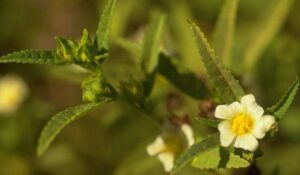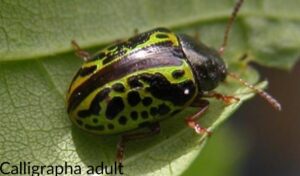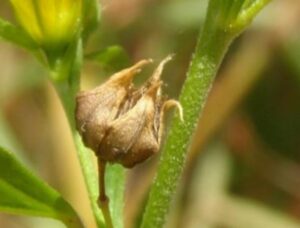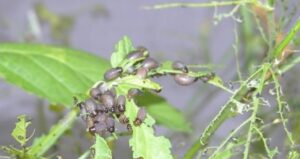Biological control of Sida
Distribution
A native of Central America, sida (Sida acuta) has spread throughout the tropics and sub-tropics in the Pacific and Asia. In the Northern Territory it is common in the Darwin, Katherine, Gulf and Victoria River regions.
Background
Sida is an erect shrub with woody branched stems that can grow to 1.5 metres in height. The leaves are up to 9 cm long and 4 cm wide and tapered at both ends in a lance shape with serrated edges. It has small yellow flowers that are usually singular, and seed capsules which divide into five to eight portions, each of which has two sharp points. It is spread by seeds that can catch on clothes and animal coats as well as being transported in hay or mud attached to animals and vehicles.
Spread
Sida is seldom eaten by stock, giving it a competitive edge in pastures, and even if it is eaten, the seeds are able to germinate after passing through the digestive system of stock.
This can also help to spread the seeds which can persist for long periods of time. Seedlings may still appear years after the successful removal of mature plants.

Biological control
When an introduced weed is present in an ecosystem without any of its natural predators it has an unnatural advantage over the native vegetation. Biological control is an attempt to reduce the advantage that the weed has by introducing some of its own natural predators (agents). It is not an attempt at eradication. Biological control agents weaken target weed species and make them less competitive.
Biocontrol is an extremely safe method of weed control as the predators chosen are studied closely for many years and selected because they are specific to the weed. Agents are not capable of surviving on the native vegetation of the area, and so pose no threat to the native ecosystem. They are carefully chosen to be host specific.
Calligrapha
Calligrapha (Calligrapha pantherina) is a bright green beetle which was introduced into the Northern Territory for the biological control of sida. Since 1989 it has been released in hundreds of locations throughout the Top End and has successfully controlled many sida infestations. At one location calligrapha has reduced sida densities from 22 to 6 plants per square metre over a year and reduced seed production by 94% at another location. In some places, however, it has failed to become established. Populations fluctuate greatly throughout the sida growing season and into the Dry when sida growth reduces.

Integrated control
The successful long-term management of weeds depends on a combination of biological, chemical and physical control in conjunction with good land management techniques. The release of biological control agents does not reduce the importance of controlling the weed with chemical or other methods. Successful biological control will reduce the cost of an integrated control program.

Why do calligrapha numbers fluctuate?
Calligrapha beetles need live, green sida plants to feed on and survive, and preferably a damp habitat. Their numbers fluctuate seasonally when the dry conditions reduce the amount of sida available for them. During the Wet season, when sida is abundant and actively growing, their numbers increase, usually from December through until March. Calligrapha generally disappear by June when most sida has completely died off. A population may disappear from an area altogether if there is inadequate sida to feed on, and may have to be reintroduced the following season.

Collecting and releasing calligrapha
Use of calligrapha by land managers is encouraged, particularly where its use forms part of an integrated weed control program. The beetles can be collected by anyone and spread to new plants and infestations. They can be easily found and collected from selected field sites during the Wet season while they are abundant. To find out the best locations to do this, contact the Weed Management Branch of the Department of Land Resource Management.
Beetles can be collected by hand picking them from sida plants and placing them in a small container such as an empty plastic jar. Fresh sida leaves and stems should be provided for them to
hide in and feed on, and a funnel fitted into the lid can make collection easier. 50 or more calligrapha should be released together on a sida infestation to establish a new population. Checking for eggs two or three weeks after release can confirm if a population has established. Once eggs, larvae and adults become common over an area of several square metres, the adults can be collected and moved to nearby plants to speed up the colonisation.
Because calligrapha is so dependent on healthy green sida plants, it is advisable to maintain an irrigated patch of sida throughout the Dry season to feed them. This patch needs to be at least 100 m2 and should be fenced to prevent stock from entering. Calligrapha larvae crawl into the soil to pupate before emerging as adult beetles. In areas where the soils are dry and compacted the beetle may not multiply and it may be necessary to control an infestation of sida either chemically or mechanically.
Management of calligrapha on sida
The following tables provide a guide to the management of calligrapha on sida in the Northern Territory.
| Situation | Action |
|---|---|
| Calligrapha population established and in large numbers before April. | Spread manually to new sites. |
| Calligrapha population does not become established by December or remains in very low numbers. | Control chemically/mechanically. Maintain small colony in irrigates location, redistribute to new areas of infestation. |
| Sida infestations in cattle or horse paddocks, where soils are dry and compacted. | Control chemically/mechanically. These will serve as a resivoir for weed reinfestation by stock transporting the seeds. |
| Situation | Action |
|---|---|
| Calligrapha population established and in large numbers by December. | Calligrapha may be left to spread by itself or may be spread manually to other sites. |
| Calligrapha does not become established. | Reintroduce Calligrapha from another field location. Control Sida mechanically/chemically. |
| Calligrapha reaches peak abundance in February/March and then declines. | Sida may then be treated mechanically or leave plants to re-shoot for surviving Calligrapha. |
| Sida infestation near creek, drain, bore, swamp, billabong, fence line or irrigated paddock. | Release insects and allow them to spread naturally. If you have a number of small isolated infestations, establish the insect at each, unless they are particularly close together. |